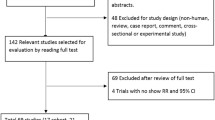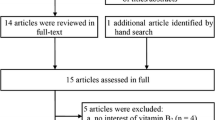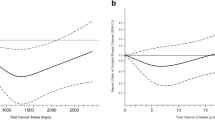Abstract
Vitamin D is not only essential in bone metabolism and calcium homeostasis but also has anticarcinogenic properties in multiple malignancies, including breast cancer. Vitamin D deficiency is a potentially modifiable risk factor that may be easily targeted for breast cancer risk reduction through supplementation. Several epidemiological studies have demonstrated an inverse relationship between dietary intake and blood levels of vitamin D and breast cancer risk; however, the results have been inconsistent. Despite some promising findings, further randomized controlled trials of vitamin D supplements are needed to determine the role of vitamin D in breast cancer prevention.

Similar content being viewed by others
References
Papers of particular interest, published recently, have been highlighted as: • Of importance
Siegel R, Naishadham D, Jemal A. Cancer statistics, 2012. CA Cancer J Clin. 2012;62(1):10–29.
Jemal A et al. Global cancer statistics. Ca-a Cancer J Clin. 2011;61(2):69–90.
Studzinski GP, Moore DC. Sunlight—can it prevent as well as cause cancer? Cancer Res. 1995;55(18):4014–22.
Gorham ED, Garland FC, Garland CF. Sunlight and breast cancer incidence in the USSR. Int J Epidemiol. 1990;19(4):820–4.
Garland FC et al. Geographic variation in breast cancer mortality in the United States: a hypothesis involving exposure to solar radiation. Prev Med. 1990;19(6):614–22.
Blot WJ, Fraumeni Jr JF, Stone BJ. Geographic patterns of breast cancer in the United States. J Natl Cancer Inst. 1977;59(5):1407–11.
Welsh J. Vitamin D and breast cancer: insights from animal models. Am J Clin Nutr. 2004;80(6 Suppl):1721S–4S.
Looker AC et al. Serum 25-hydroxyvitamin D status of the US population: 1988–1994 compared with 2000–2004. Am J Clin Nutr. 2008;88(6):1519–27.
Wortsman J et al. Decreased bioavailability of vitamin D in obesity. Am J Clin Nutr. 2000;72(3):690–3.
Giovannucci E. Vitamin D status and cancer incidence and mortality. Adv Exp Med Biol. 2008;624:31–42.
Hewison M et al. 1alpha-Hydroxylase and the action of vitamin D. J Mol Endocrinol. 2000;25(2):141–8.
Schwartz GG et al. Human prostate cells synthesize 1,25-dihydroxyvitamin D3 from 25-hydroxyvitamin D3. Cancer Epidemiol Biomarkers Prev. 1998;7(5):391–5.
Carlberg C, Dunlop TW. The impact of chromatin organization of vitamin D target genes. Anticancer Res. 2006;26(4A):2637–45.
Colston KW, Hansen CM. Mechanisms implicated in the growth regulatory effects of vitamin D in breast cancer. Endocr Relat Cancer. 2002;9(1):45–59.
Feldman D et al. The role of vitamin D in reducing cancer risk and progression. Nat Rev Cancer. 2014;14(5):342–57. A review article that explores the anti-malignant properties and mechanisms of action of vitamin D and its potential role in prevention in multiple cancers.
Abbas S, Linseisen J, Chang-Claude J. Dietary vitamin D and calcium intake and premenopausal breast cancer risk in a German case-control study. Nutr Cancer. 2007;59(1):54–61.
Levi F et al. Dietary intake of selected micronutrients and breast-cancer risk. Int J Cancer. 2001;91(2):260–3.
Potischman N et al. Intake of food groups and associated micronutrients in relation to risk of early-stage breast cancer. Int J Cancer. 1999;82(3):315–21.
Rossi M et al. Vitamin D intake and breast cancer risk: a case-control study in Italy. Ann Oncol. 2009;20(2):374–8.
Simard A, Vobecky J, Vobecky JS. Vitamin D deficiency and cancer of the breast: an unprovocative ecological hypothesis. Can J Public Health. 1991;82(5):300–3.
Frazier AL et al. Adolescent diet and risk of breast cancer. Cancer Causes Control. 2004;15(1):73–82.
John EM, Vitamin D, et al. Vitamin D and breast cancer risk: the NHANES I Epidemiologic follow-up study, 1971–1975 to 1992. National Health and Nutrition Examination Survey. Cancer Epidemiol Biomarkers Prev. 1999;8(5):399–406.
Lin J et al. Intakes of calcium and vitamin D and breast cancer risk in women. Arch Intern Med. 2007;167(10):1050–9.
McCullough ML et al. Dairy, calcium, and vitamin D intake and postmenopausal breast cancer risk in the Cancer Prevention Study II Nutrition Cohort. Cancer Epidemiol Biomarkers Prev. 2005;14(12):2898–904.
Robien K, Cutler GJ, Lazovich D. Vitamin D intake and breast cancer risk in postmenopausal women: the Iowa Women’s Health Study. Cancer Causes Control. 2007;18(7):775–82.
Shin MH et al. Intake of dairy products, calcium, and vitamin d and risk of breast cancer. J Natl Cancer Inst. 2002;94(17):1301–11.
Chen P et al. Meta-analysis of vitamin D, calcium and the prevention of breast cancer. Breast Cancer Res Treat. 2010;121(2):469–77.
Frazier AL et al. Adolescent diet and risk of breast cancer. Cancer Causes Control. 2004;15(1):73–82.
Kuper H et al. Prospective study of solar exposure, dietary vitamin D intake, and risk of breast cancer among middle-aged women. Cancer Epidemiol Biomarkers Prev. 2009;18(9):2558–61.
Gonzalez CA, Riboli E. Diet and cancer prevention: contributions from the European Prospective Investigation into Cancer and Nutrition (EPIC) study. Eur J Cancer. 2010;46(14):2555–62.
Edvardsen K et al. Vitamin D-effective solar UV radiation, dietary vitamin D and breast cancer risk. Int J Cancer. 2011;128(6):1425–33.
Abbas S et al. Dietary intake of vitamin D and calcium and breast cancer risk in the European Prospective Investigation into Cancer and Nutrition. Nutr Cancer. 2013;65(2):178–87.
Kim Y, Je Y. Vitamin D intake, blood 25(OH)D levels, and breast cancer risk or mortality: a meta-analysis. Br J Cancer. 2014;110(11):2772–84. A recent meta-analysis restricted to only prospective cohort studies that explores both the relationship of vitamin D intake and 25-hydroxyvitamin D serum levels with breast cancer risk.
Ross AC et al. The 2011 report on dietary reference intakes for calcium and vitamin D from the Institute of Medicine: what clinicians need to know. J Clin Endocrinol Metab. 2011;96(1):53–8.
World Health Organization. Prevention and management of osteoporosis. World Health Organization Technical Report Series. 2003;921:1–164.
Zerwekh JE. Blood biomarkers of vitamin D status. Am J Clin Nutr. 2008;87(4):1087S–91S.
Holick MF. Vitamin D status: measurement, interpretation, and clinical application. Ann Epidemiol. 2009;19(2):73–8.
Crew KD et al. Association between plasma 25-hydroxyvitamin D and breast cancer risk. Cancer Prev Res (Phila). 2009;2(6):598–604.
Garland CF et al. Vitamin D and prevention of breast cancer: pooled analysis. J Steroid Biochem Mol Biol. 2007;103(3–5):708–11.
Abbas S, Chang-Claude J, Linseisen J. Plasma 25-hydroxyvitamin D and premenopausal breast cancer risk in a German case-control study. Int J Cancer. 2009;124(1):250–5.
Abbas S et al. Serum 25-hydroxyvitamin D and risk of post-menopausal breast cancer—results of a large case-control study. Carcinogenesis. 2008;29(1):93–9.
Freedman DM et al. Serum levels of vitamin D metabolites and breast cancer risk in the prostate, lung, colorectal, and ovarian cancer screening trial. Cancer Epidemiol Biomarkers Prev. 2008;17(4):889–94.
McCullough ML et al. Serum 25-hydroxyvitamin D concentrations and postmenopausal breast cancer risk: a nested case control study in the Cancer Prevention Study-II Nutrition Cohort. Breast Cancer Res. 2009;11(4):R64.
Rejnmark L et al. Reduced prediagnostic 25-hydroxyvitamin D levels in women with breast cancer: a nested case-control study. Cancer Epidemiol Biomarkers Prev. 2009;18(10):2655–60.
Engel P et al. Serum 25(OH) vitamin D and risk of breast cancer: a nested case-control study from the French E3N cohort. Cancer Epidemiol Biomarkers Prev. 2010;19(9):2341–50.
Wang D et al. Serum 25-hydroxyvitamin D and breast cancer risk: a meta-analysis of prospective studies. Tumour Biol. 2013;34(6):3509–17.
Ordonez-Mena JM et al. Serum 25-hydroxyvitamin d and cancer risk in older adults: results from a large German prospective cohort study. Cancer Epidemiol Biomarkers Prev. 2013;22(5):905–16.
Kuhn T et al. Plasma 25-hydroxyvitamin D and the risk of breast cancer in the European prospective investigation into cancer and nutrition: a nested case-control study. Int J Cancer. 2013;133(7):1689–700.
Mohr SB et al. Serum 25-hydroxyvitamin D and breast cancer in the military: a case-control study utilizing pre-diagnostic serum. Cancer Causes Control. 2013;24(3):495–504.
Scarmo S et al. Circulating levels of 25-hydroxyvitamin D and risk of breast cancer: a nested case-control study. Breast Cancer Res. 2013;15(1):R15.
Almquist M et al. Serum levels of vitamin D, PTH and calcium and breast cancer risk—a prospective nested case-control study. Int J Cancer. 2010;127(9):2159–68.
Skaaby T et al. Prospective population-based study of the association between serum 25-hydroxyvitamin-D levels and the incidence of specific types of cancer. Cancer Epidemiol Biomarkers Prev. 2014;23(7):1220–9.
Xie SP, Pirianov G, Colston KW. Vitamin D analogues suppress IGF-I signalling and promote apoptosis in breast cancer cells. Eur J Cancer. 1999;35(12):1717–23.
Colston KW et al. Growth inhibition of both MCF-7 and Hs578T human breast cancer cell lines by vitamin D analogues is associated with increased expression of insulin-like growth factor binding protein-3. J Mol Endocrinol. 1998;20(1):157–62.
Bezemer ID et al. C-peptide, IGF-I, sex-steroid hormones and adiposity: a cross-sectional study in healthy women within the European Prospective Investigation into Cancer and Nutrition (EPIC). Cancer Causes Control. 2005;16(5):561–72.
Lukanova A et al. Body mass index, circulating levels of sex-steroid hormones, IGF-I and IGF-binding protein-3: a cross-sectional study in healthy women. Eur J Endocrinol. 2004;150(2):161–71.
Chen WY et al. Associations between polymorphisms in the vitamin D receptor and breast cancer risk. Cancer Epidemiol Biomarkers Prev. 2005;14(10):2335–9.
Guy M et al. Vitamin D receptor gene polymorphisms and breast cancer risk. Clin Cancer Res. 2004;10(16):5472–81.
Uitterlinden AG et al. Vitamin D receptor gene polymorphisms in relation to Vitamin D related disease states. J Steroid Biochem Mol Biol. 2004;89–90(1–5):187–93.
Buyru N et al. Vitamin D receptor gene polymorphisms in breast cancer. Exp Mol Med. 2003;35(6):550–5.
Bretherton-Watt D et al. Vitamin D receptor gene polymorphisms are associated with breast cancer risk in a UK Caucasian population. Br J Cancer. 2001;85(2):171–5.
Ingles SA et al. Vitamin D receptor genotype and breast cancer in Latinas (United States). Cancer Causes Control. 2000;11(1):25–30.
Curran JE et al. Association of A vitamin D receptor polymorphism with sporadic breast cancer development. Int J Cancer. 1999;83(6):723–6.
John EM et al. Sun exposure, vitamin D receptor gene polymorphisms, and breast cancer risk in a multiethnic population. Am J Epidemiol. 2007;166(12):1409–19.
McCullough ML et al. Vitamin D pathway gene polymorphisms, diet, and risk of postmenopausal breast cancer: a nested case-control study. Breast Cancer Res. 2007;9(1):R9.
Guy M et al. Approaches to evaluating the association of vitamin D receptor gene polymorphisms with breast cancer risk. Recent Results Cancer Res. 2003;164:43–54.
Durrin LK et al. Vitamin D receptor 3'-untranslated region polymorphisms: lack of effect on mRNA stability. Biochim Biophys Acta. 1999;1453(3):311–20.
Whitfield GK et al. Functionally relevant polymorphisms in the human nuclear vitamin D receptor gene. Mol Cell Endocrinol. 2001;177(1–2):145–59.
Trabert B et al. Vitamin D receptor polymorphisms and breast cancer risk in a large population-based case–control study of Caucasian and African-American women. Breast Cancer Res. 2007;9(6):R84.
Ruggiero M et al. Vitamin D receptor gene polymorphism is associated with metastatic breast cancer. Oncol Res. 1998;10(1):43–6.
Afzal S et al. Genetically low vitamin D concentrations and increased mortality: mendelian randomisation analysis in three large cohorts. BMJ. 2014;349:g6330. Recent study using Mendelian randomization to examine the effect of genetically driven vitamin D concentration on cancer mortality.
Ahn J et al. Genome-wide association study of circulating vitamin D levels. Hum Mol Genet. 2010;19(13):2739–45.
Wang TJ et al. Common genetic determinants of vitamin D insufficiency: a genome-wide association study. Lancet. 2010;376(9736):180–8.
Abbas S et al. The Gc2 allele of the vitamin D binding protein is associated with a decreased postmenopausal breast cancer risk, independent of the vitamin D status. Cancer Epidemiol Biomarkers Prev. 2008;17(6):1339–43.
Reimers LL, et al. Vitamin D-related gene polymorphisms, plasma 25-hydroxyvitamin D, and breast cancer risk. Cancer Causes Control. 2015;26(2):187–203.
Jones G. Pharmacokinetics of vitamin D toxicity. Am J Clin Nutr. 2008;88(2):582S–6S.
Lappe JM et al. Vitamin D and calcium supplementation reduces cancer risk: results of a randomized trial. Am J Clin Nutr. 2007;85(6):1586–91.
Chlebowski RT et al. Calcium plus vitamin D supplementation and the risk of breast cancer. J Natl Cancer Inst. 2008;100(22):1581–91.
Wactawski-Wende J et al. Calcium plus vitamin D supplementation and the risk of colorectal cancer. N Engl J Med. 2006;354(7):684–96.
Manson JE et al. The VITamin D and OmegA-3 TriaL (VITAL): rationale and design of a large randomized controlled trial of vitamin D and marine omega-3 fatty acid supplements for the primary prevention of cancer and cardiovascular disease. Contemp Clin Trials. 2012;33(1):159–71.
Boyd NF et al. Mammographic breast density as an intermediate phenotype for breast cancer. Lancet Oncol. 2005;6(10):798–808.
McCormack VA, dos Santos Silva I. Breast density and parenchymal patterns as markers of breast cancer risk: a meta-analysis. Cancer Epidemiol Biomarkers Prev. 2006;15(6):1159–69.
Brisson J et al. Synchronized seasonal variations of mammographic breast density and plasma 25-hydroxyvitamin d. Cancer Epidemiol Biomarkers Prev. 2007;16(5):929–33.
Berube S et al. Vitamin D and calcium intakes from food or supplements and mammographic breast density. Cancer Epidemiol Biomarkers Prev. 2005;14(7):1653–9.
Diorio C et al. Influence of insulin-like growth factors on the strength of the relation of vitamin D and calcium intakes to mammographic breast density. Cancer Res. 2006;66(1):588–97.
Colangelo LA et al. A pilot study of vitamin D, calcium, and percent breast density in Hispanic women. Nutr Res. 2006;26(1):11–5.
Crew KD et al. Mammographic density and serum 25-hydroxyvitamin D levels. Nutr Metab (Lond). 2014;11:18.
Knight JA et al. No association between 25-hydroxyvitamin D and mammographic density. Cancer Epidemiol Biomark Prev. 2006;15(10):1988–92.
Green AK et al. Mammographic density, plasma vitamin D levels and risk of breast cancer in postmenopausal women. Int J Cancer. 2010;127(3):667–74.
Chai W, Maskarinec G, Cooney RV. Serum 25-hydroxyvitamin D levels and mammographic density among premenopausal women in a multiethnic population. Eur J Clin Nutr. 2010;64(6):652–4.
Neuhouser ML et al. Serum vitamin D and breast density in breast cancer survivors. Cancer Epidemiol Biomarkers Prev. 2010;19(2):412–7.
Crew KD et al. Safety, feasibility, and biomarker effects of high-dose Vitamin D supplementation among women at high risk for breast cancer. Int J Food Sci Nutr Diet. 2015;S1(100):1–9.
Compliance with Ethics Guidelines
Conflict of Interest
Jennifer K. Lue and Katherine D. Crew declare that they have no conflicts of interest.
Human and Animal Rights and Informed Consent
This article does not contain any studies with human or animal subjects performed by any of the authors.
Author information
Authors and Affiliations
Corresponding author
Additional information
This article is part of the Topical Collection on Risk, Prevention, and Screening
Rights and permissions
About this article
Cite this article
Lue, J.K., Crew, K.D. Vitamin D and Reduction of Breast Cancer Risk. Curr Breast Cancer Rep 7, 90–97 (2015). https://doi.org/10.1007/s12609-015-0180-5
Published:
Issue Date:
DOI: https://doi.org/10.1007/s12609-015-0180-5




